On 3 November, the Bank of England announced the highest interest rate rise in 33 years. It warned that the UK is facing the longest recession since records began. With the downturn starting earlier than expected and predicted to last for longer, households, businesses and the government are braced for a challenging few years ahead.
Interest rates
 The Monetary Policy Committee increased Bank Rate to 3% from the previous rate of 2.25%. This 75-basis point increase is the largest since 1989 and is the eighth rise since December. What is more, the Bank has warned that it will not stop there. These increases in interest rates are there to try to tackle inflation, which rose to 10.1% in September and is expected to be 11% for the final quarter of this year. Soaring prices are a growing concern for UK households, with the cost of living rising at the fastest rate for 40 years. It is feared that such increases in the Bank’s base rate will only worsen household circumstances.
The Monetary Policy Committee increased Bank Rate to 3% from the previous rate of 2.25%. This 75-basis point increase is the largest since 1989 and is the eighth rise since December. What is more, the Bank has warned that it will not stop there. These increases in interest rates are there to try to tackle inflation, which rose to 10.1% in September and is expected to be 11% for the final quarter of this year. Soaring prices are a growing concern for UK households, with the cost of living rising at the fastest rate for 40 years. It is feared that such increases in the Bank’s base rate will only worsen household circumstances.
There are various causes of the current cost-of-living crisis. These include the pandemic’s effect on production, the aftermath in terms of supply-chain problems and labour shortages, the war in Ukraine and its effect on energy and food prices, and poor harvests in many parts of the world, including many European countries. It has been reported that grocery prices in October were 4.7% higher than in October 2021. This is the highest rate of food price inflation on record and means shoppers could face paying an extra £682 per year on average.
There is real concern about the impact of the interest rates rise on the overall economy but, in particular, on peoples’ mortgages. Bank of England Governor, Andrew Bailey, warned of a ‘tough road ahead’ for UK households, but said that the MPC had to act forcefully now or things ‘will be worse later on’.
However, it could be argued that there was a silver lining in Thursday’s announcement. The future rises in interest rates are predicted to peak at a lower rate than previously thought. Amongst all the mini-budget chaos, there was concern that rates could surpass the 6% mark. Now the Bank of England has given the assurance that future rate rises will be limited and that Bank Rate should not increase beyond 5% by next autumn. The Bank was keen to reassure markets of this by making clear the thinking behind the decision in the published minutes of MPC meeting.
Recession
 With the Bank warning of the longest recession since records began, what does this actually mean? Economies experience periods of growth and periods of slowdown or even decline in real GDP. However, a recession is defined as when a country’s economy shrinks for two three-month periods (quarters) in a row. The last time the UK experienced a recession was in 2020 during the height of the pandemic. During a recession, businesses typically make less profits, pay falls, some people may lose their jobs and unemployment rises. This means that the government receives less money in taxation to use on public services such as health and education. Graduates and school leavers could find it harder to get their first job, while others may find it harder to be promoted or to get big enough pay rises to keep pace with price increases. However, the pain of a recession is typically not felt equally across society, and inequality can increase.
With the Bank warning of the longest recession since records began, what does this actually mean? Economies experience periods of growth and periods of slowdown or even decline in real GDP. However, a recession is defined as when a country’s economy shrinks for two three-month periods (quarters) in a row. The last time the UK experienced a recession was in 2020 during the height of the pandemic. During a recession, businesses typically make less profits, pay falls, some people may lose their jobs and unemployment rises. This means that the government receives less money in taxation to use on public services such as health and education. Graduates and school leavers could find it harder to get their first job, while others may find it harder to be promoted or to get big enough pay rises to keep pace with price increases. However, the pain of a recession is typically not felt equally across society, and inequality can increase.
The Bank had previously expected the UK to fall into recession at the end of this year but the latest data from the Office for National Statistics (ONS) show that GDP fell by 0.3% in the three months to August. The Bank is predicting that GDP will shrink by 0.5% between May and August 2023, followed by a further fall of 0.3% between September and December. The Bank then expects the UK economy to remain in recession throughout 2023 and the first half of 2024.
With the higher interest rates, borrowing costs are now at their highest since 2008, when the UK banking system faced collapse in the wake of the global financial crisis. The Bank believes that by raising interest rates it will make it more expensive to borrow and encourage people not to spend money, easing the pressure on prices in the process. It does, however, mean that savers will start to benefit from higher rates (but still negative real rates), but it will have a knock-on effect on those with mortgages, credit card debt and bank loans.
The recession in 2020 only lasted for six months, although the 20.4% reduction in the UK economy between April and June that year was the largest on record. The one before that started in 2008 with the global financial crisis and went on for five quarters. Whilst it will not be the UK’s deepest downturn, the Bank stressed that it will be the longest since records began in the 1920s.
Mortgages
 Those with mortgages are rightly feeling nervous about the impact that further increases in mortgage interest rates will have on their budgets. Variable mortgage rates and new fixed rates have been rising for several months because of this year’s run of rate rises but they shot up after the mini-Budget. The Bank forecasts that if interest rates continue to rise, those whose fixed rate deals are coming to an end could see their annual payments soar by an average of £3000.
Those with mortgages are rightly feeling nervous about the impact that further increases in mortgage interest rates will have on their budgets. Variable mortgage rates and new fixed rates have been rising for several months because of this year’s run of rate rises but they shot up after the mini-Budget. The Bank forecasts that if interest rates continue to rise, those whose fixed rate deals are coming to an end could see their annual payments soar by an average of £3000.
Homebuyers with tracker or variable rate mortgages will feel the pain of the rate rise immediately, while the estimated 300 000 people who must re-mortgage this month will find that two-year and five-year fixed rates remain at levels not seen since the 2008 financial crisis. However, the Bank said that the cost of fixed-rate mortgages had already come down from the levels seen at the height of the panic in the wake of Kwasi Kwarteng’s mini-Budget, which sent them soaring above 6%.
There is a fear of the devastating impact on those who simply cannot afford further increases in payments. The Joseph Rowntree Foundation (JRF) said an extra 120 000 households in the UK, the equivalent of 400 000 people, will be plunged into poverty when their current mortgage deal ends. The analysis assumes that mortgage rates remain high, with homeowners forced to move to an interest rate of around 5.5%. For people currently on fixed rates typically of around of 2% which are due to expire, this change would mean a huge increase. Such people, on average, would find the proportion of their monthly income going on housing costs rising from 38% to 54%. In cash terms this equates to an average increase of £250, from £610 a month to £860 a month.
In addition to these higher monthly home-loan costs threatening to pull another 400 000 people into poverty, such turmoil in the mortgage market would increase competition for rental properties and could result in rents for new lets rising sharply as the extra demand allows buy-to-let landlords to pass on their higher loan costs (or more).
Unemployment
Since the mini-Budget, the level of the pound and government borrowing costs have somewhat recovered. However, mortgage markets and business loans are still showing signs of stress, adding to the prolonged hit to the economy. The Bank now forecasts that the unemployment rate will rise, while household incomes will come down too. The unemployment rate is currently at its lowest for 50 years, but it is expected to rise to nearly 6.5%.
Looking to the future
 It is the case that the lasting effects of the pandemic, the war in Ukraine and the energy shock have all played their part in the current economic climate. However, it could be argued that the Bank and the government are now making decisions that will inflict further pain and sacrifice for millions of households, who are already facing multi-thousand-pound increases in mortgage, energy and food bills.
It is the case that the lasting effects of the pandemic, the war in Ukraine and the energy shock have all played their part in the current economic climate. However, it could be argued that the Bank and the government are now making decisions that will inflict further pain and sacrifice for millions of households, who are already facing multi-thousand-pound increases in mortgage, energy and food bills.
There have been further concerns raised about the possible tax rises planned by the Chancellor Jeremy Hunt. If large tax rises and spending cuts are set out in the Autumn Statement of 17 November, the Bank of England’s chief economist has warned that Britain risks a deeper than expected economic slowdown. This could weigh on the British economy by more than the central bank currently anticipates, in a development that would force it to rethink its approach to setting interest rates.
There is no doubt that the future economic picture looks painful, with the UK performing worse than the USA and the eurozone. The Bank Governor, Andrew Bailey, believes that the mini-Budget had damaged the UK’s reputation internationally, stating, ‘it was very apparent to me that the UK’s position and the UK’s standing had been damaged’. However, both the Governor and the Chancellor or the Exchequer agree that action needs to be taken now in order for the economy to stabilise long term.
Jeremey Hunt, the Chancellor, explained that the most important thing the British government can do right now is to restore stability, sort out the public finances and get debt falling so that interest rate rises are kept as low as possible. This echoes the Bank’s belief in the importance of acting forcefully now in order to prevent things being much worse later on. With the recession predicted to last into 2024, the same year as a possible general election, the Conservatives face campaigning to remain in government at the tail end of a prolonged slump.
Report
Articles
- Bank of England expects UK to fall into longest ever recession
BBC News, Dearbail Jordan & Daniel Thomas (4/11/22)
- What is a recession and how could it affect me?
BBC News (3/11/22)
- Is it right to raise interest rates in a recession?
BBC News, Faisal Islam (4/11/22)
- Rising interest rates: why the Bank of England has increased rates again and what to expect next
The Conversation, Francesc Rodriguez-Tous (7/11/22)
- Bank of England raises interest rates by 0.75 percentage points
Financial Times, Chris Giles and Delphine Strauss (3/11/22)
- Bank of England raises its benchmark rate by 75 basis points, its biggest hike in 33 years
CNBC, Elliot Smith (3/11/22)
- Interest rate rises to 3% as Bank of England imposes biggest hike for three decades
Sky News, Ed Conway (3/11/22)
 Interest Rates: What’s behind the rise?
Interest Rates: What’s behind the rise?Sky News on YouTube, Paul Kelso (3/11/22)
- Falls in UK mortgage rates predicted as BoE signals dovish outlook
Financial Times, James Pickford and Siddharth Venkataramakrishnan (3/11/22)
- BoE outlines two bleak scenarios for taming inflation
Financial Times, Chris Giles (3/11/22)
- Bank of England warns of longest recession in 100 years as it raises rates to 3%
The Guardian, Larry Elliott and Phillip Inman (3/11/22)
- UK mortgage rate rises ‘will put extra 400,000 people in poverty’
The Guardian, Zoe Wood (4/11/22)
- Large tax rises from Jeremy Hunt ‘could put UK at risk of deeper slowdown’
The Guardian, Richard Partington (7/11/22)
- Bank of England will raise interest rates again, says chief economist
The Guardian, Richard Partington (8/11/22)
Questions
- Define the term ‘recession’ and how is it measured.
- Explain what happens to the key macroeconomic indicators during this period of the business cycle.
- Which policies would governments normally implement to get a economy into the
- expansionary/recovery phase of the business cycle and how do they work?
- What is the issue of raising interest rates during a downturn or recession?
- With unemployment expected to rise, explain what type of unemployment this is. What policies could be introduced to reduce this type of unemployment?
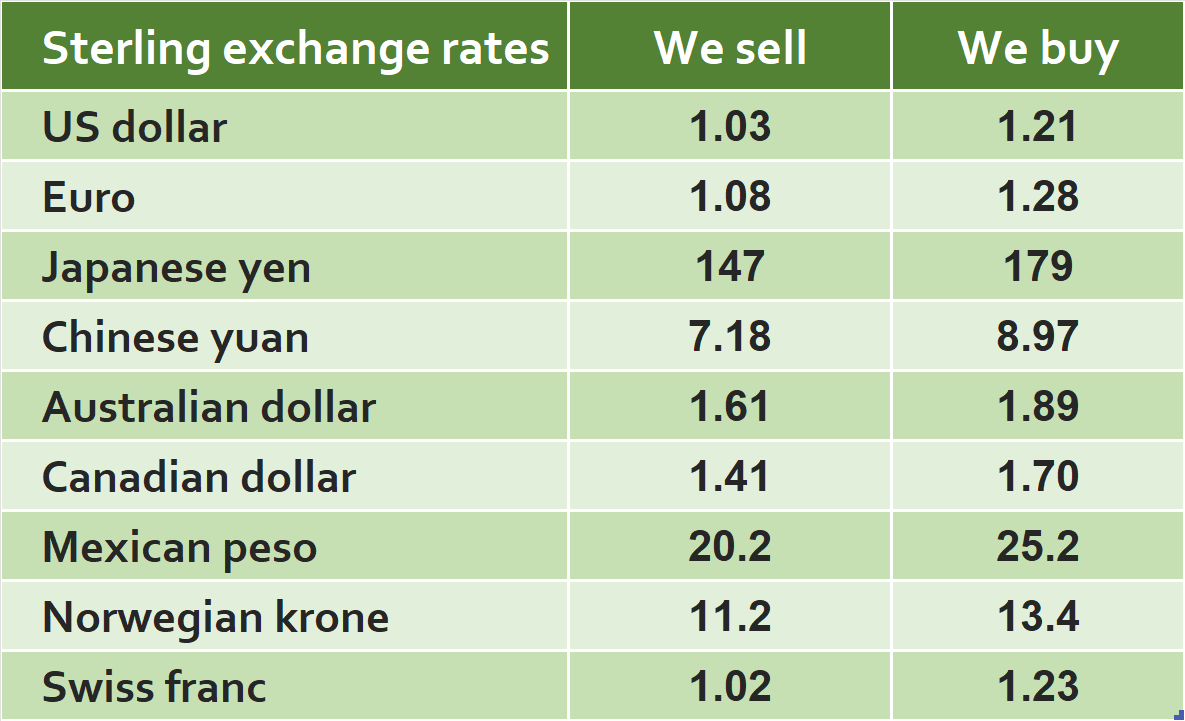 On 23 September, the new Chancellor of the Exchequer, Kwasi Kwarteng, announced his mini-Budget. It revealed big tax-cutting plans with the aim of stimulating economic growth. See the blog From Reaganomics to Trussonomics for details. However, the announcement triggered a crisis of confidence in the markets. The government says the measures will kickstart economic growth, but with the tax cuts funded through extra government borrowing, markets have raised alarm over the plans, sending the pound plunging.
On 23 September, the new Chancellor of the Exchequer, Kwasi Kwarteng, announced his mini-Budget. It revealed big tax-cutting plans with the aim of stimulating economic growth. See the blog From Reaganomics to Trussonomics for details. However, the announcement triggered a crisis of confidence in the markets. The government says the measures will kickstart economic growth, but with the tax cuts funded through extra government borrowing, markets have raised alarm over the plans, sending the pound plunging.
On Monday 26 September, traders in the UK awoke to see that the pound had fallen to the new lowest level on record against the dollar of $1.03. Although it came at a time when the markets expected the pound to weaken, the announcement pushed a fall in the pound beyond previous expectations. Concerns about where the extra money would come from to pay for the tax cuts were reflected in market movements. A weaker currency suggests investors’ faith in a country’s economic prospects is wavering.
What does a falling pound mean?
The pound’s value affects everyone – from shoppers to business owners and investors. The main impacts of the falling pound include:
- Higher prices. A fall in the value of the pound will increase the price of goods and services imported into the UK from overseas. When the pound is weak against the dollar, it costs more for companies in the UK to buy things such as food, raw materials or parts from abroad. Firms are likely then to pass on some or all those higher costs to their customers.
- Higher mortgage repayments. By increasing inflation, a falling pound is likely to push the Bank of England to raise interest rates to counter this. With two million people in the UK on a tracker or variable rate mortgage, monthly costs could increase substantially. Lenders are also likely to increase the rates charged on credit cards, bank loans or car loans.
- Further pressure on energy costs. The price of all of the gas that the UK uses is based on the dollar – even if the gas is produced in the UK. As oil prices are based on the dollar, petrol and diesel could also be more expensive for UK drivers as it costs more to be imported by fuel companies. Although the dollar price of oil has been falling in recent weeks, consumers are not likely to see the benefit at the pump due to the slide in the value of the pound.
- Stronger sales for UK firms who sell goods abroad. Some businesses in the UK could get a boost from a fall in the value of the pound. A cheaper pound makes it less expensive for people from around the globe to buy goods and services from British firms, making them more competitive.
- More expensive trips abroad. The plunge in the pound means that people’s holiday money won’t stretch as far, particularly for anyone planning a trip to the USA. The depreciation of the pound could also see airlines face sharply increased costs, with fuel and aircraft leases often denominated in dollars.
Threat to confidence
The Bank of England said a weaker outlook for the UK economy as well as a stronger dollar were putting pressure on sterling. However, market responses were clear that Kwarteng’s mini-Budget was threatening to undermine confidence in the UK. The pound plunged to its lowest since Britain went decimal in 1971, as belief in the UK’s economic management and assets evaporated.
By Tuesday 27 September, there were expectations that the Bank of England would have to raise interest rates to counter the extra spending in the mini-Budget. Economists from the City suggested the slump in the pound would not just force the Bank of England into raising rates at the next MPC announcement in November, but to intervene now by announcing an emergency interest rate rise to support the currency. This sent mortgage activity into a frenzy as brokers worked around the clock to help clients secure deals before lenders pulled their products or replaced them with more expensive ones. By the end of the week there were 40% fewer products available than before the mini-Budget.
The Bank of England
 In August, the Bank predicted that the UK would go into recession, lasting some 15 months. It did so as it raised interest rates by the highest margin in 27 years (0.5 percentage points) in a bid to keep soaring prices under control. Higher interest rates can make borrowing more expensive, meaning people have less money to spend and prices will stop rising as quickly. The Bank of England is expected to raise interest rates by an even larger amount to combat the inflationary impact of the mini-Budget, as a weakening pound drives up costs of imports. The money markets are pricing a doubling of UK interest rates to more than 5% by next summer.
In August, the Bank predicted that the UK would go into recession, lasting some 15 months. It did so as it raised interest rates by the highest margin in 27 years (0.5 percentage points) in a bid to keep soaring prices under control. Higher interest rates can make borrowing more expensive, meaning people have less money to spend and prices will stop rising as quickly. The Bank of England is expected to raise interest rates by an even larger amount to combat the inflationary impact of the mini-Budget, as a weakening pound drives up costs of imports. The money markets are pricing a doubling of UK interest rates to more than 5% by next summer.
On Thursday 29 September the cost of government borrowing was rising to levels many economists thought were concerning. After the mini-Budget, the UK Debt Management Office, which borrows on behalf of the government by issuing new government bonds (‘gilts’), plans to raise an additional £72bn before next April, raising the financing remit in 2022/23 to £234bn. The investors in bonds are mainly large institutions, such as pension funds.
New bonds are issued at a fixed payment per annum based on the face value. If interest rates rise, then new bonds must pay a higher amount per annum to attract purchasers. Old bonds with a relatively low payment per year will fall in value. For example, if a £100 bond issued a while back paid £2 per annum (a nominal 2%) and interest rates on equivalent assets rose to 4%, the market price of the bond would fall to £50, as £2 per annum is 4% of £50. This percentage of the market price (as opposed to the face value) is known as the ‘yield’. With worries about the rise in government borrowing, bond prices fell and yields correspondingly rose. Investors were demanding much higher interest rates to lend to the UK government.
 The Investment Director at JM Finn compared investing in government bonds to sloths, they’re low risk and typically don’t move. This is because lending to the UK is usually considered as an ultra-safe bet. However, some bonds fell in price by 20% in two days (26–28 September).
The Investment Director at JM Finn compared investing in government bonds to sloths, they’re low risk and typically don’t move. This is because lending to the UK is usually considered as an ultra-safe bet. However, some bonds fell in price by 20% in two days (26–28 September).
There was concern that the mini-Budget threatened the financial health of Britain’s biggest pensions and insurance companies, which together manage trillions of pounds of people’s cash. These companies hold large amounts of UK government bonds and the fall in their price was significantly reducing the value of their assets.
The Bank of England thus announced that it would step in to calm markets, warning that continued volatility would be a ‘material risk to UK financial stability’. The Bank would start buying government bonds at an ‘urgent pace’ to help push their price back up and restore orderly market conditions. It would set aside £65bn to buy bonds over 13 working days. It is hoped that the Bank’s action will now ease the pressure on pension funds and insurance companies.
But the purchase of bonds increases money supply. This was the process by which money supply was increased during periods of quantitative easing (QE). Increasing money supply, while helping to dampen the rise in interest rates and stabilise the financial markets, is likely to lead to higher inflation. The Bank of England had previously planned to do the opposite: to engage in quantitative tightening (QT), which involves selling some of the stock of (old) bonds which the Bank had accumulated during the various rounds of QE.
Despite the Bank of England’s action which helped to curb the fall in the sterling exchange rate, some analysts warned it could fall further and could even reach parity with the dollar. There are concerns that the Bank is simply firefighting, rather than being able to solve the wider problems. There is now growing pressure on the government to make clear the financial cost of its tax cuts and spending plans.
Criticism from the IMF
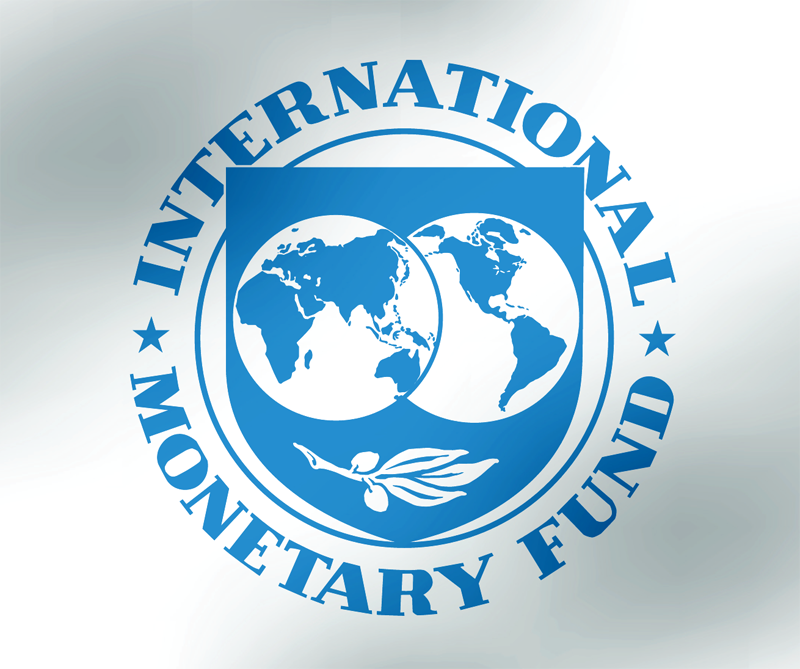 There has been widespread criticism of the government’s plan, with the International Monetary Fund warning on Tuesday 27 September that the measures were likely to fuel the cost-of-living crisis and increase inequality. The stinging rebuke from the IMF arrived at the worst moment for the UK government. The IMF works to stabilise the global economy and one of its key roles is to act as an early economic warning system. It said it understood the package aimed to boost growth, but it warned that the cuts could speed up the pace of price rises, which the UK’s central bank is trying to bring down. In an unusually outspoken statement, the IMF said the proposal was likely to increase inequality and add to pressures pushing up prices.
There has been widespread criticism of the government’s plan, with the International Monetary Fund warning on Tuesday 27 September that the measures were likely to fuel the cost-of-living crisis and increase inequality. The stinging rebuke from the IMF arrived at the worst moment for the UK government. The IMF works to stabilise the global economy and one of its key roles is to act as an early economic warning system. It said it understood the package aimed to boost growth, but it warned that the cuts could speed up the pace of price rises, which the UK’s central bank is trying to bring down. In an unusually outspoken statement, the IMF said the proposal was likely to increase inequality and add to pressures pushing up prices.
Mark Carney, the former Governor of the Bank of England also criticised the government, accusing them of ‘undercutting’ the UK’s key economic institutions. Mr Carney said that while the government was right to want to boost economic growth, ‘There is a lag between today and when that growth might come.’ He also criticised the government for undercutting various institutions that underpin the overall approach, including not having an OBR forecast.
What is next for the economy?
Before the announcement, the Bank had expected the economy to shrink in the last three months of 2022 and keep shrinking until the end of 2023. However, some economists believe the UK could already be in recession. The impacts of the mini-Budget have so far not alleviated fears of the UK diving into recession. However, the Governor of the Bank of England, Andrew Bailey, also warned that little could be done to stop the UK falling into a recession this year as the war in Ukraine continued. He added that it would ‘overwhelmingly be caused by the actions of Russia and the impact on energy prices’.
Despite the external pressures on the economy, it is clear that recent market activity has damaged confidence. The Bank has already said it will ‘not hesitate’ to hike interest rates to try to protect the pound and stem surging prices. Some economists have predicted the Bank of England will raise the interest rate from the current 2.25% to 5.75% by next spring.
The Bank’s action of emergency bond purchases helped provide Kwarteng with some respite from the financial markets after three days of turmoil, which included strong criticism of the mini-Budget from the International Monetary Fund, about 1000 mortgage products pulled and interest rates on UK government bonds hitting their highest level since 2008.
On 3 October, at the start of the Conservative Party annual conference, Kwarteng announced that the planned cut in the top rate of income tax from 45% to 40% would not go ahead. This showed that the government would change course if pressure was strong enough. That day, the sterling exchange rate against the dollar appreciated by around 0.5% to around $1.12.
But this was not enough. The pressure was still on the government. There were urgent calls from the House of Commons Treasury Select Committee to bring forward the government’s financial statement, which was not due until 23 November, by at least a month. The government was urged to publish growth forecasts as soon as possible to help calm the markets. In response, on 4 October the government agreed to bring the financial statement forward to late October along with the forecasts of its impacts from the OBR.
However, Truss and Kwarteng have so far resisted this pressure to bring analysis of their tax plans forward. They have refused independent analysis of their plans until more than six weeks after receiving them, despite more calls from Tory MPs for Downing Street to reassure the markets. The Prime Minister and Chancellor said they would only publish the independent forecasts on 23 November alongside a fiscal statement, despite them being ready on 7 October.
Longer term impacts
Amongst all the activity in the week following the mini-Budget, there are real concerns of the longer-term impacts the budget will have on the economy. Some experts predict that the lasting effects of the ‘mini’ Budget will be felt far beyond the trading floors. Large tax cuts the government claimed would boost growth have instead convinced markets the UK’s entire macroeconomic framework is under threat. Although this turmoil has been the short-term result, it’s important to step back and think about how the effects of this abrupt shift in economic policy will be felt far beyond the trading floors.
 Sterling’s partial recovery a few days after the mini-Budget reflects an increased confidence that there will be a large interest rate rise coming on November 3. However, the bleak economic outlook has removed any fiscal headroom the government may have had. The largest tax cuts in five decades need funding, while spooking the markets means another £12.5bn a year added to the debt interest bill. However, Kwarteng remains committed to debt falling eventually.
Sterling’s partial recovery a few days after the mini-Budget reflects an increased confidence that there will be a large interest rate rise coming on November 3. However, the bleak economic outlook has removed any fiscal headroom the government may have had. The largest tax cuts in five decades need funding, while spooking the markets means another £12.5bn a year added to the debt interest bill. However, Kwarteng remains committed to debt falling eventually.
It is estimated that there needs to be a fiscal tightening of around £37–£47bn by 2026/27. Even more could be required to ensure that tax revenues cover day-to-day spending or for even a small margin for error. Many have therefore called for a U-turn on the measures announced in the mini-Budget beyond abolishing the cut to the top rate of income tax. Performing a U-turn on some of the tax cuts would make the fiscal tightening much more achievable. However, it could be politically detrimental. Much lower taxes will mean less public spending. Some suggest that this trade-off was ignored when those tax cuts were announced, but market pressure has now put it centre stage.
The Prime Minister has since admitted that mistakes were made in the controversial ‘mini’ Budget that sparked market turmoil in the last week of September. However, a day before reversing the cut in the top rate of income tax, she said she would not retreat on her plan to deliver £45bn of unfunded tax cuts, insisting it would help deliver growth, but admitted: ‘We should have laid the ground better and I have learned from that.’
Articles
- Pound hits all-time low against dollar after mini-budget rocks markets
The Guardian, Graeme Wearden (26/9/22)
- The pound: Why is it falling?
BBC News, Tom Edgington (27/9/22)
- Falling pound: What does it mean for me and my finances?
BBC News, Lora Jones (28/9/22)
- Bank of England steps in to calm markets
BBC News, Daniel Thomas and Noor Nanji (29/9/22)
- Government is undercutting UK institutions, says former Bank governor
BBC News, Dearbail Jordan (30/9/22)
- Bank of England in £65bn scramble to avert financial crisis
The Guardian, Larry Elliott, Pippa Crerar and Richard Partington (28/9/22)
 From mini-budget to market turmoil: Kwasi Kwarteng’s week – video timeline
From mini-budget to market turmoil: Kwasi Kwarteng’s week – video timelineThe Guardian, Elena Morresi and Monika Cvorak plus sources as credited (30/9/22)
- Truss and Kwarteng resist pressure to bring analysis of their tax plans forward
The Guardian, Rowena Mason and Aubrey Allegretti (30/9/22)
- Mark Carney accuses Truss government of undermining Bank of England
The Guardian, Kalyeena Makortoff (29/9/22)
- Lasting effects of ‘mini’ Budget will be felt far beyond the trading floors
The Times, Torsten Bell (1/10/22)
- ‘Big impact’: UK economic chaos, pound plunge hit businesses
ABC News, Sylvia Hui and Kelvin Chan (30/9/22)
- Bank of England bonds rescue has two ugly implications: more inflation and an even weaker pound
The Conversation, Costas Milas (30/9/22)
- Sterling hits all-time low: two things can turn this around but neither is straightforward
The Conversation, Jean-Philippe Serbera (26/9/22)
Questions
- Explain how the announced tax cut will stimulate economic growth.
- What is the impact of the weakened pound on UK households and businesses?
- Draw a diagram illustrating the way in which the $/£ exchange rate is determined.
- How is UK inflation likely to be affected by a depreciation of sterling?
- Are there any advantages of having a lower pound?
Bubbles
 Speculation in markets can lead to wild swings in prices as exuberance drives up prices and
Speculation in markets can lead to wild swings in prices as exuberance drives up prices and
pessimism leads to price crashes. When the rise in price exceeds underlying fundamentals, such as profit, the result is a bubble. And bubbles burst.
There have been many examples of bubbles throughout history. One of the most famous is that of tulips in the 17th century. As Box 2.4 in Essential Economics for Business (6th edition) explains:
Between November 1636 and February 1637, there was a 20-fold increase in the price of tulip bulbs, such that a skilled worker’s annual salary would not even cover the price of one bulb. Some were even worth more than a luxury home! But, only three months later, their price had fallen by 99 per cent. Some traders refused to pay the high price and others began to sell their tulips. Prices began falling. This dampened demand (as tulips were seen to be a poor investment) and encouraged more people to sell their tulips. Soon the price was in freefall, with everyone selling. The bubble had burst .
Another example was the South Sea Bubble of 1720. Here, shares in the South Sea Company, given a monopoly by the British government to trade with South America, increased by 900% before collapsing through a lack of trade.
Another, more recent, example is that of Poseidon. This was an Australian nickel mining company which announced in September 1969 that it had discovered a large seam of nickel at Mount Windarra, WA. What followed was a bubble. The share price rose from $0.80 in mid-1969 to a peak of $280 in February 1970 and then crashed to just a few dollars.
Other examples are the Dotcom bubble of the 1990s, the US housing bubble of the mid-2000s and BitCoin, which has seen more than one bubble.
Bubbles always burst eventually. If you buy at a low price and sell at the peak, you can make a lot of money. But many will get their fingers burnt. Those who come late into the market may pay a high price and, if they are slow to sell, can then make a large loss.
GameStop shares – an unlikely candidate for a bubble
 The most recent example of a bubble is GameStop. This is a chain of shops in the USA selling games, consoles and other electronic items. During the pandemic it has struggled, as games consumers have turned to online sellers of consoles and online games. It has been forced to close a number of stores. In July 2020, its share price was around $4. With the general recovery in stock markets, this drifted upwards to just under $20 by 12 January 2021.
The most recent example of a bubble is GameStop. This is a chain of shops in the USA selling games, consoles and other electronic items. During the pandemic it has struggled, as games consumers have turned to online sellers of consoles and online games. It has been forced to close a number of stores. In July 2020, its share price was around $4. With the general recovery in stock markets, this drifted upwards to just under $20 by 12 January 2021.
Then the bubble began.
Hedge fund shorting
Believing that the GameStop shares were now overvalued and likely to fall, many hedge funds started shorting the shares. Shorting (or ‘short selling’) is where investors borrow shares for a fee and immediately sell them on at the current price, agreeing to return them to the lender on a specified day in the near future (the ‘expiration date’). But as the investors have sold the shares they borrowed, they must now buy them at the current price on or before the expiration date so they can return them to the lenders. If the price falls between the two dates, the investors will gain. For example, if you borrow shares and immediately sell them at a current price of £5 and then by the expiration date the price has fallen to $2 and you buy them back at that price to return them to the lender, you make a £3 profit.
But this is a risky strategy. If the price rises between the two dates, investors will lose – as events were to prove.
The swarm of small investors
 Enter the ‘armchair investor’. During lockdown, small-scale amateur investing in shares has become a popular activity, with people seeking to make easy gains from the comfort of their own homes. This has been facilitated by online trading platforms such as Robinhood and Trading212. These are easy and cheap, or even free, to use.
Enter the ‘armchair investor’. During lockdown, small-scale amateur investing in shares has become a popular activity, with people seeking to make easy gains from the comfort of their own homes. This has been facilitated by online trading platforms such as Robinhood and Trading212. These are easy and cheap, or even free, to use.
What is more, many users of these sites were also collaborating on social media platforms, such as Reddit. They were encouraging each other to buy shares in GameStop and some other companies. In fact, many of these small investors were seeing it as a battle with large-scale institutional investors, such as hedge funds – a David vs. Goliath battle.
With swarms of small investors buying GameStop, its share price surged. From $20 on 12 January, it doubled in price within two days and had reached $77 by 25 January. The frenzy on Reddit then really gathered pace. The share price peaked at $468 early on 28 January. It then fell to $126 less than two hours later, only to rise again to $354 at the beginning of the next day.
Many large investors who had shorted GameStop shares made big losses. Analytics firm Ortex estimated that hedge funds lost a total of $12.5 billion in January. Many small investors, however, who bought early and sold at the peak made huge gains. Other small investors who got the timing wrong made large losses.
And it was not just GameStop. Social media were buzzing with suggestions about buying shares in other poorly performing companies that large-scale institutional investors were shorting. Another target was silver and silver mines. At one point, silver prices rose by more than 10% on 1 February. However, money invested in silver is huge relative to GameStop and hence small investors were unlikely to shift prices by anything like as much as GameStop shares.
Amidst this turmoil, the US Securities and Exchange Commission (SEC) issued a statement on 29 January. It warned that it was working closely with other regulators and the US stock exchange ‘to ensure that regulated entities uphold their obligations to protect investors and to identify and pursue potential wrongdoing’. It remains to be seen, however, what it can do to curb the concerted activities of small investors. Perhaps, only the experience of bubbles bursting and the severe losses that can result will make small investors think twice about backing failing companies. Some Davids may beat Goliath; others will be defeated.
Articles
- GameStop: The competing forces trading blows over lowly gaming retaile
Sky News (30/1/21)
- Tempted to join the GameStop ‘angry mob’? Lessons on bubbles, market abuse and stock picking from the investment experts… including perma-bear Albert Edwards
This is Money, Tanya Jefferies (29/1/21)
- A year ago on Reddit I suggested investing in GameStop. But I never expected this
The Guardian, Desmund Delaney (29/1/21)
- The real lesson of the GameStop story is the power of the swarm
The Guardian, Brett Scott (30/1/21)
- GameStop: What is it and why is it trending?
BBC News, Kirsty Grant (29/1/21)
- GameStop: Global watchdogs sound alarm as shares frenzy grows
BBC News (30/1/21)
- The GameStop affair is like tulip mania on steroids
The Guardian, Dan Davies (29/1/21)
- GameStop news: Short sellers lose $19bn as Omar says billionaires who pressured apps should go to jail
Independent, Andy Gregory, Graig Graziosi and Justin Vallejo (30/1/21)
- Robinhood tightens GameStop trading curbs again as SEC weighs in
Financial Times, Michael Mackenzie, Colby Smith, Kiran Stacey and Miles Kruppa (29/1/21)
- SEC Issues Vague Threats Against Everyone Involved in the GameStop Stock Saga
Gizmodo, Andrew Couts (29/1/21)
- SEC warns it is monitoring trade after GameStop surge
RTE News (29/1/21)
- GameStop short-squeeze losses at $12.5 billion YTD – Ortex data
Reuters (1/2/21)
- GameStop: I’m one of the WallStreetBets ‘degenerates’ – here’s why retail trading craze is just getting started
The Conversation, Mohammad Rajjaque (3/2/21)
- What the GameStop games really mean
Shares Magazine, Russ Mould (4/2/21)
Data
Questions
- Distinguish between stabilising and destabilising speculation.
- Use a demand and supply diagram to illustrate destabilising speculation.
- Explain how short selling contributed to the financial crisis of 2007/8 (see Box 2.7 in Economics (10th edition) or Box 3.4 in Essentials of Economics (8th edition)).
- Why won’t shares such as GameStop go on rising rapidly in price for ever? What limits the rise?
- Find out some other shares that have been trending among small investors. Why were these specific shares targeted?
- How has quantitative easing impacted on stock markets? What might be the effect of a winding down of QE or even the use of quantitative tightening?
 The BBC podcast linked below looks at the use of quantitative easing since 2009 and especially the most recent round since the onset of the pandemic.
The BBC podcast linked below looks at the use of quantitative easing since 2009 and especially the most recent round since the onset of the pandemic.
Although QE was a major contributor to reducing the depth of the recession in 2009–10, it was barely used from 2013 to 2020 (except for a short period in late 2016/early 2017). The Coalition and Conservative governments were keen to get the deficit down. In justifying pay restraint and curbing government expenditure, Prime Ministers David Cameron and Theresa May both argued that there ‘was no magic money tree’.
But with the severely dampening effect of the lockdown measures from March 2020, the government embarked on a large round of expenditure, including the furlough scheme and support for businesses.
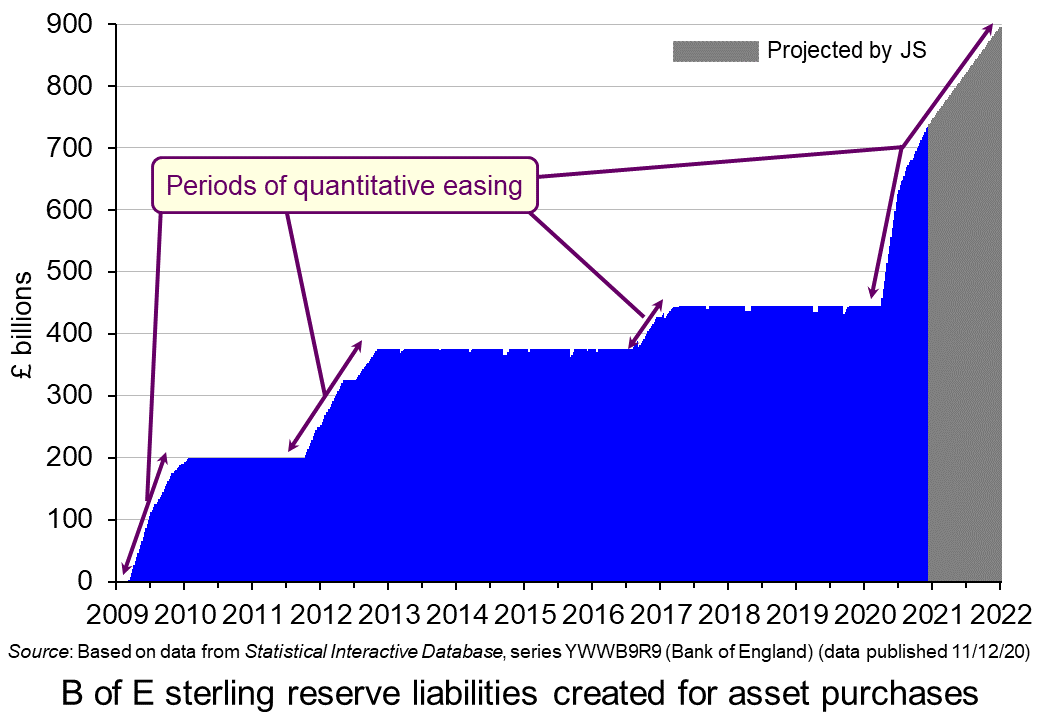 The resulting rise in the budget deficit was accompanied by a new round of QE from the beginning of April. The stock of assets purchased by the Bank of England rose from £445 billion (the approximate level it had been since March 2017) to £740 billion by December 2020 and is planned to reach £895 billion by the end of 2021.
The resulting rise in the budget deficit was accompanied by a new round of QE from the beginning of April. The stock of assets purchased by the Bank of England rose from £445 billion (the approximate level it had been since March 2017) to £740 billion by December 2020 and is planned to reach £895 billion by the end of 2021.
So with the effective funding of the government’s deficits by the creation of new money, does this mean that there is indeed a ‘magic money tree’ or, indeed, a ‘magic money forest’? And if so, is it desirable? Is it simply stoking up problems for the future? Or will, as modern monetary theorists maintain, the extra money, if carefully spent, lead to faster growth and a reducing deficit, with low interest rates making it easy to service the debt?
The podcast explores these issues. There is then a longer list of questions than normal relating to the topics raised in the podcast.
Podcast
Questions
- Which of the following are stocks and which are flows?
(a) Money
(b) Income
(c) The total amount people save each month
(d) The money held in savings accounts
(e) Public-sector net debt
(f) Public-sector net borrowing
(g) National income
(h) Injections into the circular flow of income
(i) Aggregate demand
(j) Wealth
- How do banks create money?
- What is the role of the Debt Management Office in the sale of gilts?
- Describe the birth of QE.
- Is raising asset prices the best means of stimulating the economy? What are the disadvantages of this form of monetary expansion?
- What are the possible exit routes from QE and what problems could occur from reducing the central bank’s stock of assets?
- Is the use of QE in the current Covid-19 crisis directly related to fiscal policy? Or is this use of monetary policy simply a means of hitting the inflation target?
- What are the disadvantages of having interest rates at ultra-low levels?
- Does it matter if the stock of government debt rises substantially if the gilts are at ultra-low fixed interest rates?
- What are the intergenerational effects of substantial QE? Does it depend on how debt is financed?
- How do the policy recommendations of modern monetary theorists differ from those of more conventional macroeconomists?
- In an era of ultra-low interest rates, does fiscal policy have a greater role to play than monetary policy?
 On 25 November, the UK government published its Spending Review 2020. This gives details of estimated government expenditure for the current financial year, 2020/21, and plans for government expenditure and the likely totals for 2021/22.
On 25 November, the UK government published its Spending Review 2020. This gives details of estimated government expenditure for the current financial year, 2020/21, and plans for government expenditure and the likely totals for 2021/22.
The focus of the Review is specifically on the effects of and responses to the coronavirus pandemic. It does not consider the effects of Brexit, with or without a trade deal, or plans for taxation. The Review is based on forecasts by the Office for Budget Responsibility (OBR). Because of the high degree of uncertainty over the spread of the disease and the timing and efficacy of vaccines, the OBR gives three forecast values for most variables – pessimistic, central and optimistic.
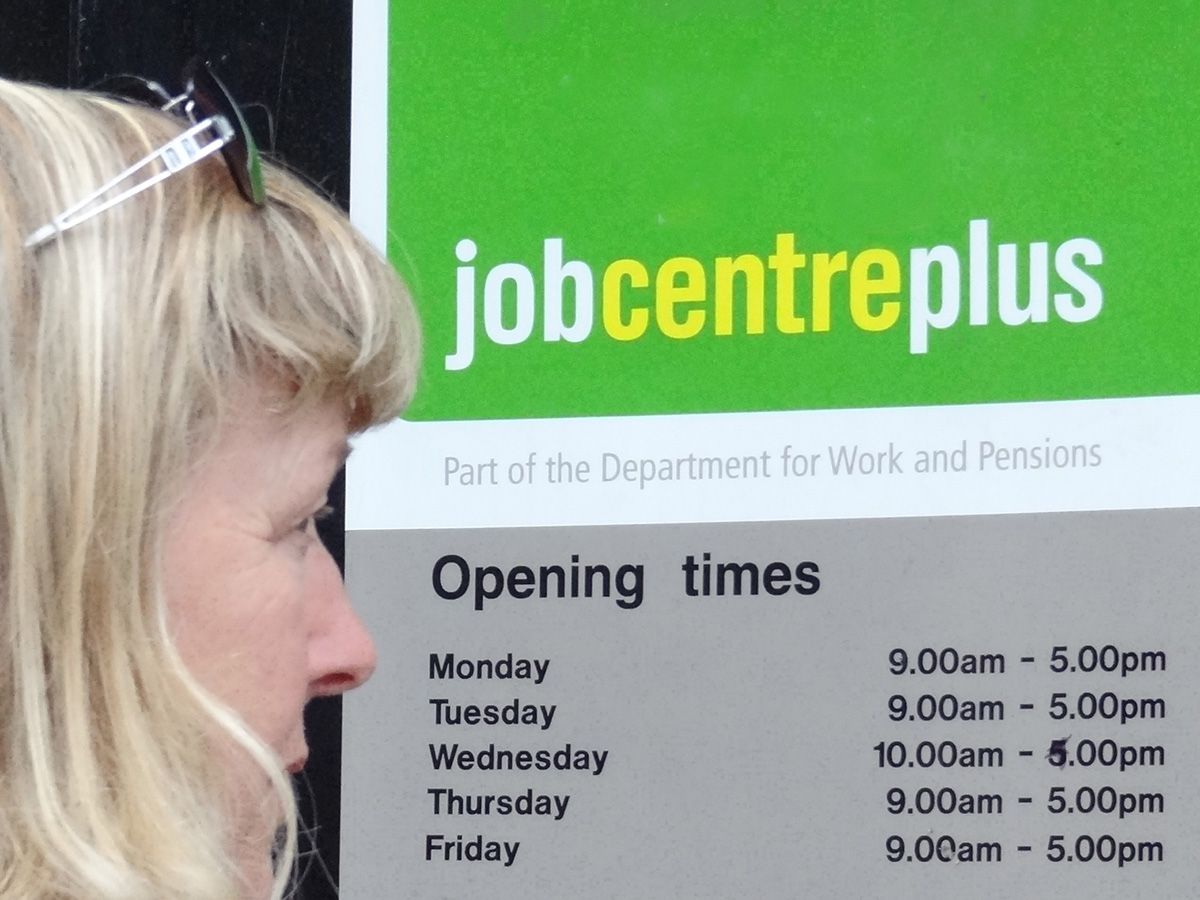 According to the central forecast, real GDP is set to decline by 11.3% in 2020, the largest one-year fall since the Great Frost of 1709. The economy is then set to ‘bounce back’ (somewhat), with GDP rising by 5.2% in 2021.
According to the central forecast, real GDP is set to decline by 11.3% in 2020, the largest one-year fall since the Great Frost of 1709. The economy is then set to ‘bounce back’ (somewhat), with GDP rising by 5.2% in 2021.
Unemployment will rise from 3.9% in 2019 to a peak of 7.5% in mid-2021, after the furlough scheme and other support for employers is withdrawn.
This blog focuses at the impact on government borrowing and debt and the implications for the future – both the funding of the debt and ways of reducing it.
Soaring government deficits and debt
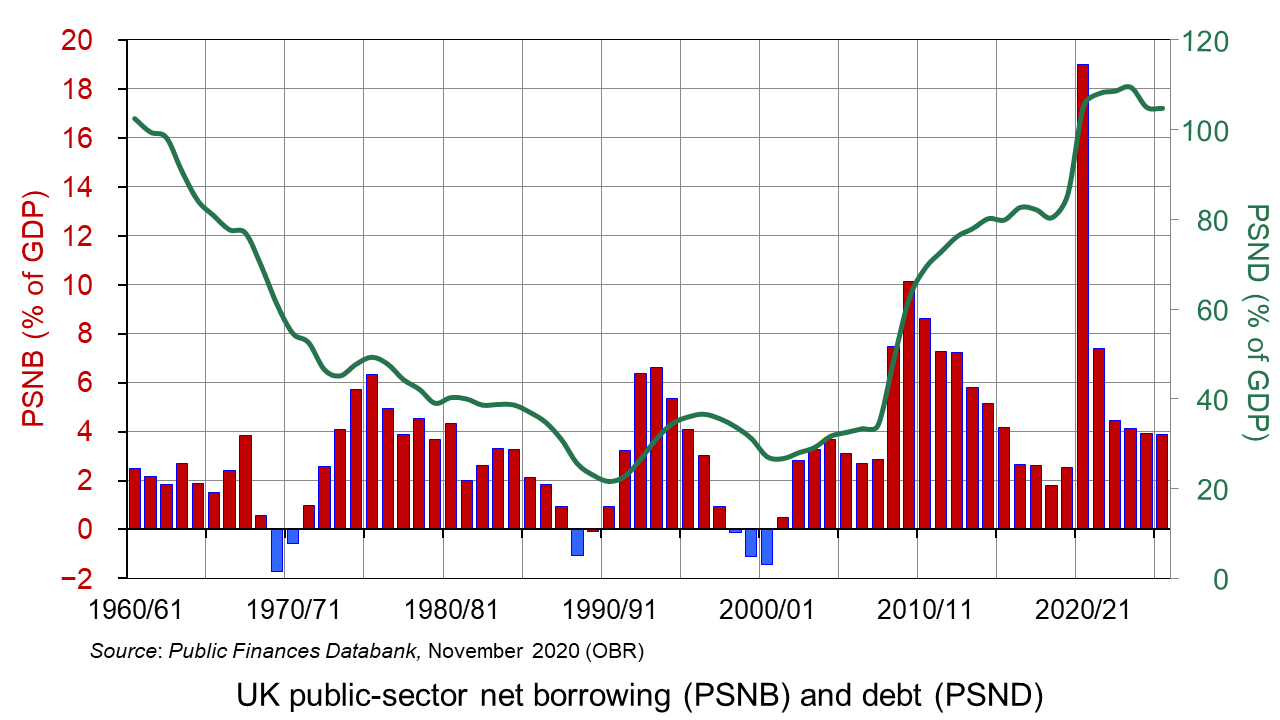
Government expenditure during the pandemic has risen sharply through measures such as the furlough scheme, the Self-Employment Income Support Scheme and various business loans. This, combined with falling tax revenue, as incomes and consumer expenditure have declined, has led to a rise in public-sector net borrowing (PSNB) from 2.5% of GDP in 2019/20 to a central forecast of 19% for 2020/21 – the largest since World War II. By 2025/26 it is still forecast to be 3.9% of GDP. The figure has also been pushed up by a fall in nominal GDP for 2020/21 (the denominator) by nearly 7%. (Click here for a PowerPoint of the above chart.)
The high levels of PSNB are pushing up public-sector net debt (PSNB). This is forecast to rise from 85.5% of GDP in 2019/20 to 105.2% in 2020/21, peaking at 109.4% in 2023/24.
The exceptionally high deficit and debt levels will mean that the government misses by a very large margin its three borrowing and debt targets set out in the latest (Autumn 2016) ‘Charter for Budget Responsibility‘. These are:
- to reduce cyclically-adjusted public-sector net borrowing to below 2% of GDP by 2020/21;
- for public-sector net debt as a percentage of GDP to be falling in 2020/21;
- for overall borrowing to be zero or in surplus by 2025/26.
But, as the Chancellor said in presenting the Review:
Our health emergency is not yet over. And our economic emergency has only just begun. So our immediate priority is to protect people’s lives and livelihoods.
Putting the public finances on a sustainable footing
Running a large budget deficit in an emergency is an essential policy for dealing with the massive decline in aggregate demand and for supporting those who have, or otherwise would have, lost their jobs. But what of the longer-term implications? What are the options for dealing with the high levels of debt?
1. Raising taxes. This tends to be the preferred approach of those on the left, who want to protect or improve public services. For them, the use of higher progressive taxes, such as income tax, or corporation tax or capital gains tax, are a means of funding such services and of providing support for those on lower incomes. There has been much discussion of the possibility of finding a way of taxing large tech companies, which are able to avoid taxes by declaring very low profits by diverting them to tax havens.
2. Cutting government expenditure. This is the traditional preference of those on the right, who prefer to cut the overall size of the state and thus allow for lower taxes. However, this is difficult to do without cutting vital services. 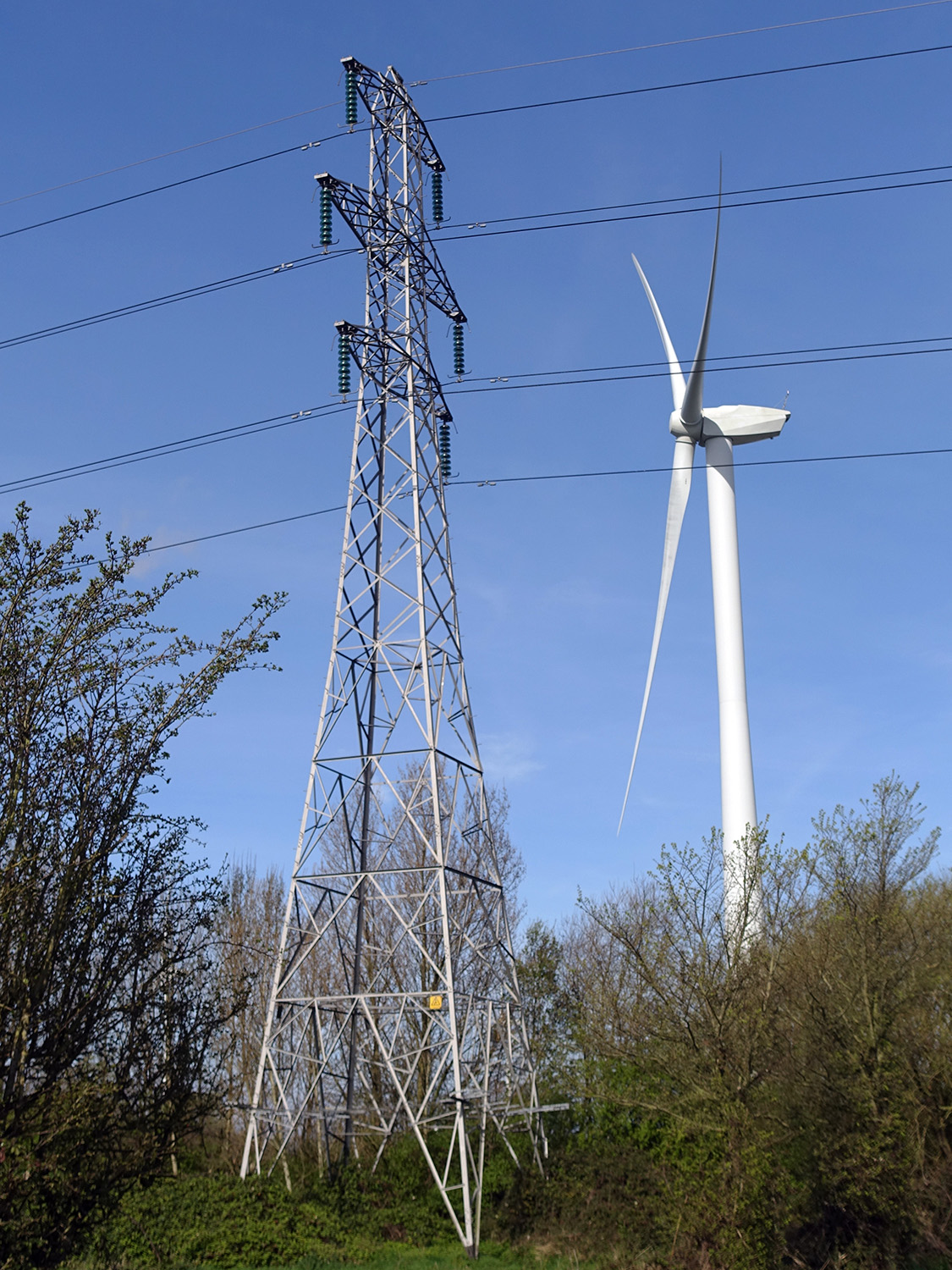 Indeed, there is pressure to have higher government expenditure over the longer term to finance infrastructure investment – something supported by the Conservative government.
Indeed, there is pressure to have higher government expenditure over the longer term to finance infrastructure investment – something supported by the Conservative government.
A downside of either of the above is that they squeeze aggregate demand and hence may slow the recovery. There was much discussion after the financial crisis over whether ‘austerity policies’ hindered the recovery and whether they created negative supply-side effects by dampening investment.
3. Accepting higher levels of debt into the longer term. This is a possible response as long as interest rates remain at record low levels. With depressed demand, loose monetary policy may be sustainable over a number of years. Quantitative easing depresses bond yields and makes it cheaper for governments to finance borrowing. Servicing high levels of debt may be quite affordable.
The problem is if inflation begins to rise. Even with lower aggregate demand, if aggregate supply has fallen faster because of bankruptcies and lack of investment, there may be upward pressure on prices. The Bank of England may have to raise interest rates, making it more expensive for the government to service its debts.
Another problem with not reducing the debt is that if another emergency occurs in the future, there will be less scope for further borrowing to support the economy.
 4. Higher growth ‘deals’ with the deficit and reduces debt. In this scenario, austerity would be unnecessary. This is the ‘golden’ scenario – for the country to grow its way out of the problem. Higher output and incomes leads to higher tax revenues, and lower unemployment leads to lower expenditure on unemployment benefits. The crucial question is the relationship between aggregate demand and supply. For growth to be sustainable and shrink the debt/GDP ratio, aggregate demand must expand steadily in line with the growth in aggregate supply. The faster aggregate supply can grow, the faster can aggregate demand. In other words, the faster the growth in potential GDP, the faster can be the sustainable rate of growth of actual GDP and the faster can the debt/GDP ratio shrink.
4. Higher growth ‘deals’ with the deficit and reduces debt. In this scenario, austerity would be unnecessary. This is the ‘golden’ scenario – for the country to grow its way out of the problem. Higher output and incomes leads to higher tax revenues, and lower unemployment leads to lower expenditure on unemployment benefits. The crucial question is the relationship between aggregate demand and supply. For growth to be sustainable and shrink the debt/GDP ratio, aggregate demand must expand steadily in line with the growth in aggregate supply. The faster aggregate supply can grow, the faster can aggregate demand. In other words, the faster the growth in potential GDP, the faster can be the sustainable rate of growth of actual GDP and the faster can the debt/GDP ratio shrink.
One of the key issues is the degree of economic ‘scarring’ from the pandemic and the associated restrictions on economic activity. The bigger the decline in potential output from the closure of firms and the greater the deskilling of workers who have been laid off, the harder it will be for the economy to recover and the longer high deficits are likely to persist.
Another issue is the lack of labour productivity growth in the UK in recent years. If labour productivity does not increase, this will severely restrict the growth in potential output. Focusing on training and examining incentives, work practices and pay structures are necessary if productivity is to rise significantly. So too is finding ways to encourage firms to increase investment in new technologies.
Podcast and videos
Articles
- Initial reaction from IFS researchers on Spending Review 2020 and OBR forecasts
IFS Press Release, Paul Johnson, Carl Emmerson, Ben Zaranko, Tom Waters and Isabel Stockton (25/11/200
- Rishi Sunak is likely to increase spending – which means tax rises will follow
IFS, Newspaper Article, Paul Johnson (23/11/20)
- Economic and Fiscal Outlook Executive Summary
OBR (25/11/20)
- UK’s Sunak says public finances are on ‘unsustainable’ path
Reuters, David Milliken (26/11/20)
- Rishi Sunak warns ‘economic emergency has only just begun’
BBC News, Szu Ping Chan (25/11/20)
- UK will need £27bn of spending cuts or tax rises, watchdog warns
The Guardian, Phillip Inman (25/11/20)
- What is tomorrow’s Spending Review all about?
The Institute of Chartered Accountants in England and Wales (24/11/20)
- Spending Review 2020: the experts react
The Conversation, Drew Woodhouse, Ernestine Gheyoh Ndzi, Jonquil Lowe, Anupam Nanda, Alex de Ruyter and Simon J. Smith (25/11/20)
OBR Data
Questions
- What is the significance of the relationship between the rate of economic growth and the rate of interest for financing public-sector debt over the longer term?
- What can the government do to encourage investment in the economy?
- Using OBR data, find out what has happened to the output gap over the past few years and what is forecast to happen to it over the next five years. Explain the significance of the figures.
- Distinguish between demand-side and supply-side policies. How would you characterise the policies to tackle public-sector net debt in terms of this distinction? Do the policies have a mixture of demand- and supply-side effects?
- Choose two other developed countries. Examine how their their public finances have been affected by the coronavirus pandemic and the policies they are adopting to tackle the economic effects of the pandemic.
 The Monetary Policy Committee increased Bank Rate to 3% from the previous rate of 2.25%. This 75-basis point increase is the largest since 1989 and is the eighth rise since December. What is more, the Bank has warned that it will not stop there. These increases in interest rates are there to try to tackle inflation, which rose to 10.1% in September and is expected to be 11% for the final quarter of this year. Soaring prices are a growing concern for UK households, with the cost of living rising at the fastest rate for 40 years. It is feared that such increases in the Bank’s base rate will only worsen household circumstances.
The Monetary Policy Committee increased Bank Rate to 3% from the previous rate of 2.25%. This 75-basis point increase is the largest since 1989 and is the eighth rise since December. What is more, the Bank has warned that it will not stop there. These increases in interest rates are there to try to tackle inflation, which rose to 10.1% in September and is expected to be 11% for the final quarter of this year. Soaring prices are a growing concern for UK households, with the cost of living rising at the fastest rate for 40 years. It is feared that such increases in the Bank’s base rate will only worsen household circumstances. With the Bank warning of the longest recession since records began, what does this actually mean? Economies experience periods of growth and periods of slowdown or even decline in real GDP. However, a recession is defined as when a country’s economy shrinks for two three-month periods (quarters) in a row. The last time the UK experienced a recession was in 2020 during the height of the pandemic. During a recession, businesses typically make less profits, pay falls, some people may lose their jobs and unemployment rises. This means that the government receives less money in taxation to use on public services such as health and education. Graduates and school leavers could find it harder to get their first job, while others may find it harder to be promoted or to get big enough pay rises to keep pace with price increases. However, the pain of a recession is typically not felt equally across society, and inequality can increase.
With the Bank warning of the longest recession since records began, what does this actually mean? Economies experience periods of growth and periods of slowdown or even decline in real GDP. However, a recession is defined as when a country’s economy shrinks for two three-month periods (quarters) in a row. The last time the UK experienced a recession was in 2020 during the height of the pandemic. During a recession, businesses typically make less profits, pay falls, some people may lose their jobs and unemployment rises. This means that the government receives less money in taxation to use on public services such as health and education. Graduates and school leavers could find it harder to get their first job, while others may find it harder to be promoted or to get big enough pay rises to keep pace with price increases. However, the pain of a recession is typically not felt equally across society, and inequality can increase. Those with mortgages are rightly feeling nervous about the impact that further increases in mortgage interest rates will have on their budgets. Variable mortgage rates and new fixed rates have been rising for several months because of this year’s run of rate rises but they shot up after the mini-Budget. The Bank forecasts that if interest rates continue to rise, those whose fixed rate deals are coming to an end could see their annual payments soar by an average of £3000.
Those with mortgages are rightly feeling nervous about the impact that further increases in mortgage interest rates will have on their budgets. Variable mortgage rates and new fixed rates have been rising for several months because of this year’s run of rate rises but they shot up after the mini-Budget. The Bank forecasts that if interest rates continue to rise, those whose fixed rate deals are coming to an end could see their annual payments soar by an average of £3000.  It is the case that the lasting effects of the pandemic, the war in Ukraine and the energy shock have all played their part in the current economic climate. However, it could be argued that the Bank and the government are now making decisions that will inflict further pain and sacrifice for millions of households, who are already facing multi-thousand-pound increases in mortgage, energy and food bills.
It is the case that the lasting effects of the pandemic, the war in Ukraine and the energy shock have all played their part in the current economic climate. However, it could be argued that the Bank and the government are now making decisions that will inflict further pain and sacrifice for millions of households, who are already facing multi-thousand-pound increases in mortgage, energy and food bills. Interest Rates: What’s behind the rise?
Interest Rates: What’s behind the rise? On 23 September, the new Chancellor of the Exchequer, Kwasi Kwarteng, announced his mini-Budget. It revealed big tax-cutting plans with the aim of stimulating economic growth. See the blog
On 23 September, the new Chancellor of the Exchequer, Kwasi Kwarteng, announced his mini-Budget. It revealed big tax-cutting plans with the aim of stimulating economic growth. See the blog  In August, the Bank predicted that the UK would go into recession, lasting some 15 months. It did so as it raised interest rates by the highest margin in 27 years (0.5 percentage points) in a bid to keep soaring prices under control. Higher interest rates can make borrowing more expensive, meaning people have less money to spend and prices will stop rising as quickly. The Bank of England is expected to raise interest rates by an even larger amount to combat the inflationary impact of the mini-Budget, as a weakening pound drives up costs of imports. The money markets are pricing a doubling of UK interest rates to more than 5% by next summer.
In August, the Bank predicted that the UK would go into recession, lasting some 15 months. It did so as it raised interest rates by the highest margin in 27 years (0.5 percentage points) in a bid to keep soaring prices under control. Higher interest rates can make borrowing more expensive, meaning people have less money to spend and prices will stop rising as quickly. The Bank of England is expected to raise interest rates by an even larger amount to combat the inflationary impact of the mini-Budget, as a weakening pound drives up costs of imports. The money markets are pricing a doubling of UK interest rates to more than 5% by next summer. The Investment Director at JM Finn compared investing in government bonds to sloths, they’re low risk and typically don’t move. This is because lending to the UK is usually considered as an ultra-safe bet. However, some bonds fell in price by 20% in two days (26–28 September).
The Investment Director at JM Finn compared investing in government bonds to sloths, they’re low risk and typically don’t move. This is because lending to the UK is usually considered as an ultra-safe bet. However, some bonds fell in price by 20% in two days (26–28 September).  There has been widespread criticism of the government’s plan, with the International Monetary Fund warning on Tuesday 27 September that the measures were likely to fuel the cost-of-living crisis and increase inequality. The stinging rebuke from the IMF arrived at the worst moment for the UK government. The IMF works to stabilise the global economy and one of its key roles is to act as an early economic warning system. It said it understood the package aimed to boost growth, but it warned that the cuts could speed up the pace of price rises, which the UK’s central bank is trying to bring down. In an unusually outspoken statement, the IMF said the proposal was likely to increase inequality and add to pressures pushing up prices.
There has been widespread criticism of the government’s plan, with the International Monetary Fund warning on Tuesday 27 September that the measures were likely to fuel the cost-of-living crisis and increase inequality. The stinging rebuke from the IMF arrived at the worst moment for the UK government. The IMF works to stabilise the global economy and one of its key roles is to act as an early economic warning system. It said it understood the package aimed to boost growth, but it warned that the cuts could speed up the pace of price rises, which the UK’s central bank is trying to bring down. In an unusually outspoken statement, the IMF said the proposal was likely to increase inequality and add to pressures pushing up prices. Sterling’s partial recovery a few days after the mini-Budget reflects an increased confidence that there will be a large interest rate rise coming on November 3. However, the bleak economic outlook has removed any fiscal headroom the government may have had. The largest tax cuts in five decades need funding, while spooking the markets means another £12.5bn a year added to the debt interest bill. However, Kwarteng remains committed to debt falling eventually.
Sterling’s partial recovery a few days after the mini-Budget reflects an increased confidence that there will be a large interest rate rise coming on November 3. However, the bleak economic outlook has removed any fiscal headroom the government may have had. The largest tax cuts in five decades need funding, while spooking the markets means another £12.5bn a year added to the debt interest bill. However, Kwarteng remains committed to debt falling eventually.  Speculation in markets can lead to wild swings in prices as exuberance drives up prices and
Speculation in markets can lead to wild swings in prices as exuberance drives up prices and The most recent example of a bubble is GameStop. This is a chain of shops in the USA selling games, consoles and other electronic items. During the pandemic it has struggled, as games consumers have turned to online sellers of consoles and online games. It has been forced to close a number of stores. In July 2020, its
The most recent example of a bubble is GameStop. This is a chain of shops in the USA selling games, consoles and other electronic items. During the pandemic it has struggled, as games consumers have turned to online sellers of consoles and online games. It has been forced to close a number of stores. In July 2020, its  Enter the ‘armchair investor’. During lockdown, small-scale amateur investing in shares has become a popular activity, with people seeking to make easy gains from the comfort of their own homes. This has been facilitated by online trading platforms such as
Enter the ‘armchair investor’. During lockdown, small-scale amateur investing in shares has become a popular activity, with people seeking to make easy gains from the comfort of their own homes. This has been facilitated by online trading platforms such as  The BBC podcast linked below looks at the use of quantitative easing since 2009 and especially the most recent round since the onset of the pandemic.
The BBC podcast linked below looks at the use of quantitative easing since 2009 and especially the most recent round since the onset of the pandemic.  The resulting
The resulting  On 25 November, the UK government published its
On 25 November, the UK government published its  According to the central forecast, real GDP is set to decline by 11.3% in 2020, the largest one-year fall since the Great Frost of 1709. The economy is then set to ‘bounce back’ (somewhat), with GDP rising by 5.2% in 2021.
According to the central forecast, real GDP is set to decline by 11.3% in 2020, the largest one-year fall since the Great Frost of 1709. The economy is then set to ‘bounce back’ (somewhat), with GDP rising by 5.2% in 2021. 
 Indeed, there is pressure to have higher government expenditure over the longer term to finance infrastructure investment – something supported by the Conservative government.
Indeed, there is pressure to have higher government expenditure over the longer term to finance infrastructure investment – something supported by the Conservative government. 4. Higher growth ‘deals’ with the deficit and reduces debt. In this scenario, austerity would be unnecessary. This is the ‘golden’ scenario – for the country to grow its way out of the problem. Higher output and incomes leads to higher tax revenues, and lower unemployment leads to lower expenditure on unemployment benefits. The crucial question is the relationship between aggregate demand and supply. For growth to be sustainable and shrink the debt/GDP ratio, aggregate demand must expand steadily in line with the growth in aggregate supply. The faster aggregate supply can grow, the faster can aggregate demand. In other words, the faster the growth in potential GDP, the faster can be the sustainable rate of growth of actual GDP and the faster can the debt/GDP ratio shrink.
4. Higher growth ‘deals’ with the deficit and reduces debt. In this scenario, austerity would be unnecessary. This is the ‘golden’ scenario – for the country to grow its way out of the problem. Higher output and incomes leads to higher tax revenues, and lower unemployment leads to lower expenditure on unemployment benefits. The crucial question is the relationship between aggregate demand and supply. For growth to be sustainable and shrink the debt/GDP ratio, aggregate demand must expand steadily in line with the growth in aggregate supply. The faster aggregate supply can grow, the faster can aggregate demand. In other words, the faster the growth in potential GDP, the faster can be the sustainable rate of growth of actual GDP and the faster can the debt/GDP ratio shrink.